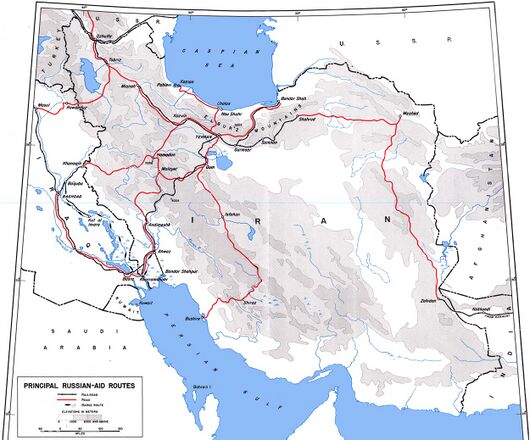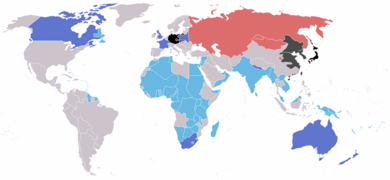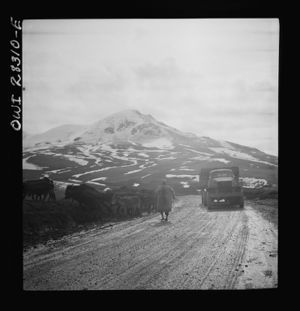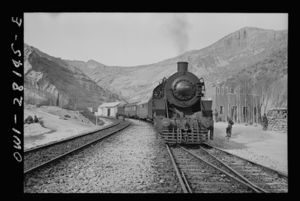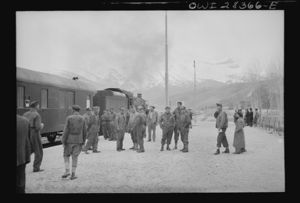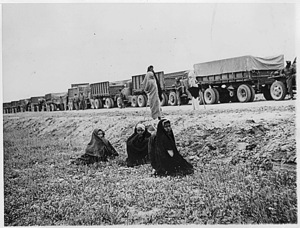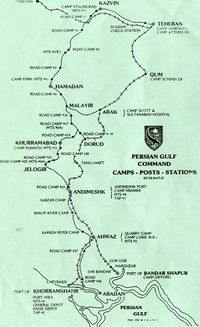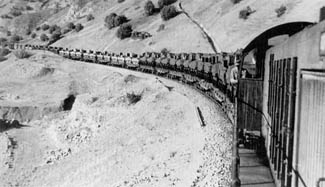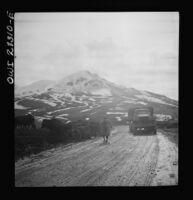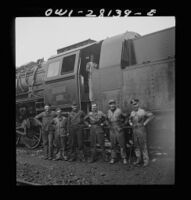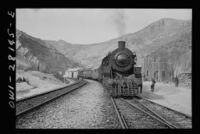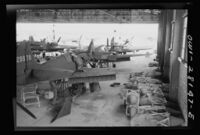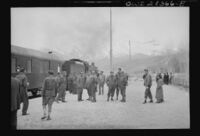الرواق الفارسي

الرواق الفارسي Persian Corridor، كان مسار إمدادات عبر إيران إلى أذربيجان السوڤيتية والذي كان يتم من خلاله توصيل المساعدات البريطانية وإمدادات الإعارة-التأجير الأمريكية حيث كان يتم نقلها إلى الاتحاد السوڤيتي.
مسار الإمدادات الذي كانيبدأ في الولايات المتحدة والمملكة المتحدة على سفن تبحر حول رأس الرجاء الصالح إلى الخليج العربي. ومن هناك، يُنقل العتاد عبر إيران إلى الاتحاد السوڤيتي. وكان هناك مسارات أخرى منها مسار شمالي عبر شمال الأطلسي، ومسار عبر المحيط الهادي يسلـّم البضائع الأمريكية في ڤلاديڤوستوك ومن ثم يستخدم سكة الحديد عبر سيبريا إلى الجبهات السوڤيتية.
المسار الفارسي أصبح الوحيد الممكن، في كل الأجواء لتزويد السوڤيت بكل احتياجاتهم.
. . . . . . . . . . . . . . . . . . . . . . . . . . . . . . . . . . . . . . . . . . . . . . . . . . . . . . . . . . . . . . . . . . . . . . . . . . . . . . . . . . . . . . . . . . . . . . . . . . . . . . . . . . . . . . . . . . . . . . . . . . . . . . . . . . . . . . . . . . . . . . . . . . . . . . . . . . . . . . . . . . . . . . . .
أصل الاسم
English-language official documents from the Persian Corridor period continue to make the word "Persia" interchangeable with the name of Iran. In correspondence by the government of the United Kingdom, usage of "Persia" over "Iran" was chosen by Winston Churchill to avoid possible confusion with neighbouring Iraq.[1]
الاطاحة بالشاه
- انظر المقالة الرئيسية الغزو الأنگلو-سوڤيتي لإيران
Following Germany's invasion of the Soviet Union in June 1941, Britain and the Soviet Union became allies. Britain and the Soviet Union saw the newly opened Trans-Iranian Railway as an attractive route to transport supplies from the Persian Gulf to the Soviet Union. Both countries used concessions extracted in previous interventions to pressure neutral Iran (and, in Britain's case, Iraq) into allowing the use of their territory for military and logistical purposes. Increased tensions with Britain led to pro-German rallies in Tehran. In August 1941, because Reza Shah refused to expel all German nationals and come down clearly on the Allied side, Britain and the Soviet Union invaded Iran, arrested the monarch, sent him into exile to South Africa and took control of Iran's communications and the coveted railway.
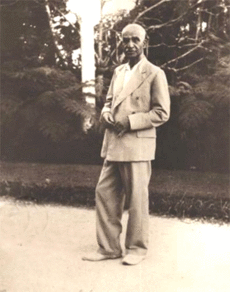
In 1942 the United States, now an ally of Britain and the Soviet Union in World War II, sent a military force to Iran to help maintain and operate sections of the railway. The British and Soviet authorities allowed Reza Shah's system of government to collapse and limited the constitutional government interfaces. They installed Reza Shah's son, Mohammad Reza Pahlavi, onto the Iranian/Persian throne.
The new Shah soon signed an agreement pledging full non-military logistical co-operation with the British and Soviets in exchange for full recognition of his country's independence, and also a promise to withdraw from Iran within six months of the war's conclusion (the assurances later proved essential in securing his country's independence after the war). In September 1943, the Shah went further by declaring war on Germany. He signed the Declaration by United Nations entitling his country to a seat in the original United Nations. Two months later, he hosted[بحاجة لمصدر] the Tehran Conference between Churchill, Roosevelt, and Stalin.
The presence of so many foreign troops in Iran accelerated social change and it roused nationalist sentiment in the country. In 1946, Hossein Gol-e-Golab published the nationalist song Ey Iran, which was reportedly inspired[بحاجة لمصدر] by an incident during the war in which Golab witnessed an American GI beating up a native Iranian greengrocer in a marketplace dispute.
الحاجة الاستراتيجية لإمداد السوڤيت
After the Dunkirk evacuation and the agreement with Vichy France, Germany was essentially without any military opposition in mainland Europe until Hitler launched Operation Barbarossa, the invasion of the Soviet Union in June 1941. To relieve pressure from the Soviets, British, and later American, leaders sought to open a Second Front in Europe. Realizing that would take time, the Western Allies made the strategic decision to provide Stalin with material support substantial enough to ensure that the Red Army could continue to engage the bulk of the German military. The Allies established protocols that defined the type and amount of material that would be delivered and when. German military action on the Arctic route, prevented the US from meeting the first protocol. That caused increasing pressure on the Allies to develop the Persian Corridor.
جهود الإمداد
The Allies delivered all manner of materiel to the Soviet Union ranging from Studebaker US6 trucks to American canned food. Most of the supplies transiting through the Persian Corridor arrived by ship at various ports in the Persian Gulf and were then carried northwards by railroad or in long truck convoys. Some goods were later reloaded on board ships to cross the Caspian Sea and others continued their journey by truck.
The United States Army forces in the corridor were originally under the Iran-Iraq Service Command, later renamed the Persian Gulf Service Command (PGSC). That was the successor to the original United States Military Iranian Mission, which had been put in place to deliver Lend-Lease supplies before the United States had entered the World War. The mission was originally commanded by Colonel Don G. Shingler, who was replaced late in 1942 by Brigadier General Donald H. Connolly. Both the Iran-Iraq Service Command and the PGSC were subordinate to the US Army Forces in the Middle East (USAFIME). The PGSC was eventually renamed simply the Persian Gulf Command.
احصائيات
Of the 17,500,000 long tons (17,800,000 t) of US lend-lease aid provided to Russia, 7,900,000 long tons (8,000,000 t) (45 per cent) were sent through Iran.[2] In addition to the Persian Corridor the Americans used Arctic Convoys to the ports of Murmansk and Archangelsk and Soviet shipping carried supplies from the west coast of the US and Canada to Vladivostok, in the Far East, since the Soviets were not at war with Japan until August 1945. The Persian Corridor was the route for 4,159,117 long tons (4,225,858 t) of the cargo.[3] That was not the only allied contribution via the Persian Corridor. About 7,900,000 long tons (8,000,000 t) of shipborne cargo from Allied sources were unloaded in the Corridor, most of it bound for the Soviet Union and some of it for British forces, under the Middle East Command, or for the Iranian economy, which was sustaining the influx of tens of thousands of foreign troops and Polish refugees. Also, supplies were needed for the development of new transport and supply facilities in Persia and in the Soviet Union. The tonnage figure does not include transfers of warplanes via Persia.
. . . . . . . . . . . . . . . . . . . . . . . . . . . . . . . . . . . . . . . . . . . . . . . . . . . . . . . . . . . . . . . . . . . . . . . . . . . . . . . . . . . . . . . . . . . . . . . . . . . . . . . . . . . . . . . . . . . . . . . . . . . . . . . . . . . . . . . . . . . . . . . . . . . . . . . . . . . . . . . . . . . . . . . .
مسارات التوريد
في إيران،
- بوشهر
- بندر شاهپور (بندر الإمام الخميني حالياً)؛ و
في العراق،
المسارات البرية من الموانئ إلى طهران، وبعدها
أو، كطرق بديلة،
الميناء الرئيسي للتوريدات (عبر بحر قزوين) هو ناوشهر. كانت السفن تنقل التوريدات من هذا الميناء إلى باكو أو محج قلعة.
مواقع أخرى
موانئ هامة أصغر ونقاط للنقل على المسارات وتشمل:
في أذربيجان
في أرمنيا
في جورجيا
في أوستيا الشمالية-ألانيا
في إيران
الموانئ
- بندر أنزلي
- بندر عباس
- چابهار
- نوشهر
- بندر شاه (حالياً بندر تركمان)
- ميناء أمير أباد
- خرم شهر
- بوشهر
- عسلويه
- ماهشهر
- ميناء بندر الإمام الخميني
- فريدونكنار [1]
في تركمنستان
موانئ
مدن
أشخاص
Cargo was principally handled by special British and American transportation units from the nations' respective combat service support branches, such as the Royal Army Service Corps and the United States Army Quartermaster Corps. Many Allied civilian workers, such as stevedores and railway engineers, were also employed on the corridor. Many skilled engineers, accountants, and other professionals who volunteered or were drafted into the armed services were made warrant officers to help oversee the complex supply operations.
In addition to providing logistical support to the Iranians, the Allies offered other services as well. The Americans in particular were viewed as more neutral since they had no colonial past in the country as did the British and Soviets. The Americans contributed special expertise to the young Shah's government. Colonel Norman Schwarzkopf, Sr., who at the outbreak of the war was serving as superintendent of the New Jersey State Police was in August 1942 put in charge of training the Imperial Iranian Gendarmerie (his son, Norman Schwarzkopf, Jr., would command coalition forces fifty years later during the Persian Gulf War.)
المعدات
To help operate trains on the demanding Trans-Iranian Railway route, the US supplied large numbers of ALCO diesel locomotives, which were more suitable than steam locomotives. About 3000 pieces of rolling stock of various types were also supplied.[4]
An assembly plant for American Curtiss P-40 fighters destined for Russia, somewhere in Iran. c.1943
نهر الڤولگا إلى ستالينگراد
بعد الرواق الفارسي وعبر بحر قزوين يوجد نهر الڤولگا، الذي ينساب إلى القزوين من الشمال، هو طريق رئيسي إلى قلب الاتحاد السوڤيتي. Stalingrad, at the easternmost turn of the Volga, was an objective of the Germans in their 1942 campaign partly for reason of its industrial capacity, partly as a convenient place to block Soviet pressure on the flank of their initiative towards the Caucasus, and partly for its name. However, it was also for blocking the river traffic carrying materiel north from the Persian Corridor. The Battle of Stalingrad (23 August 1942 – 2 February 1943) reopened the river.
. . . . . . . . . . . . . . . . . . . . . . . . . . . . . . . . . . . . . . . . . . . . . . . . . . . . . . . . . . . . . . . . . . . . . . . . . . . . . . . . . . . . . . . . . . . . . . . . . . . . . . . . . . . . . . . . . . . . . . . . . . . . . . . . . . . . . . . . . . . . . . . . . . . . . . . . . . . . . . . . . . . . . . . .
انظر أيضاً
- تاريخ إيران
- مسرح عمليات البحر المتوسط والشرق الأوسط
- التاريخ العسكري للاتحاد السوڤيتي
- المساهمة الپولندية في الحرب العالمية الثانية
- الغزو الأنگلو-سوڤيتي لإيران
- المعاهدة الأنگلو-سوڤيتية 1907
- الطريق الملكي
- العملية سيدار
- اللعبة الكبرى
هوامش
- ^ Churchill, Winston, The Second World War
- ^ خطأ استشهاد: وسم
<ref>غير صحيح؛ لا نص تم توفيره للمراجع المسماةWard2009 - ^ Kemp, Paul (2004). Convoy!: Drama in Arctic Waters. Edison, NJ: Castle Books. ISBN 0-7858-1603-8. OCLC 56497488.
- ^ "They Helped Russia to Victory". The Port Macquarie News and Hastings River Advocate (NSW : 1882–1950). NSW: National Library of Australia. 28 April 1945. p. 4. Retrieved 25 May 2013.
وصلات خارجية
- Coakley, Robert W. (2000) [1960]. "Chapter 9: The Persian Corridor as a Route for Aid to the USSR". In Greenfield, Kent Roberts (ed.). Command Decisions. Washington: United States Army Center of Military History. CMH Pub 72-7.
{{cite book}}: External link in|chapterurl=|chapterurl=ignored (|chapter-url=suggested) (help) - Motter, T.H. Vail (2000) [1952]. The Persian Corridor and Aid To Russia. Washington: United States Army Center of Military History. CMH Pub 8-1.
- Trucks Lend Leased to Russia amateur history page with detailed maps and statistics
- The North-South Iranian Corridor today
- A Forgotten Odyssey website
- Short description with empty Wikidata description
- Articles with unsourced statements from July 2021
- Articles with links needing disambiguation from May 2014
- CS1 errors: unsupported parameter
- المساعدة الاقتصادية أثناء الحرب العالمية الثانية
- سياسات الحرب العالمية الثانية
- عقد 1940 في إيران
- التاريخ العسكري للولايات المتحدة
- مسرح عمليات الشرق الأوسط في الحرب العالمية الثانية
- النقل في إيران
- العلاقات الإيرانية السوڤيتية
- العلاقات الأمريكية الإيرانية
- العلاقات الأمريكية السوڤيتية
- تاريخ أذربيجان
- لوجستيات عسكرية في الحرب العالمية الثانية
